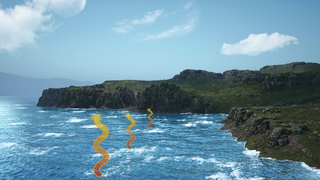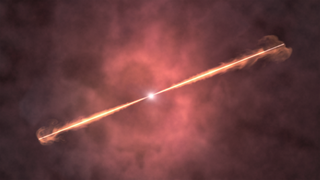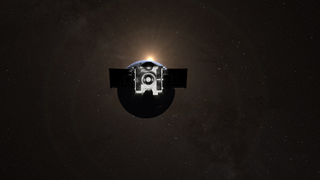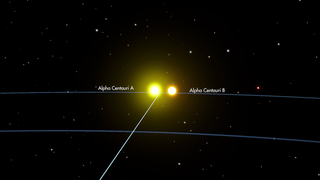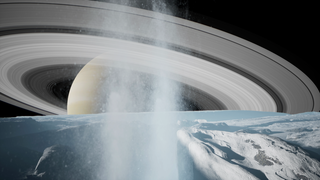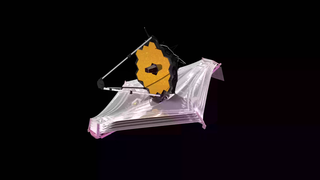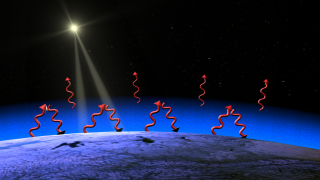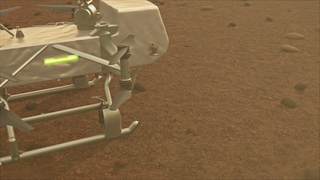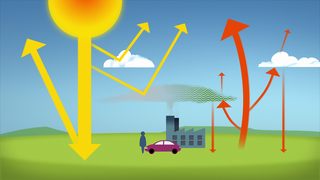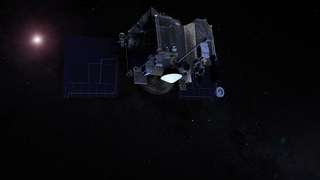Planets and Moons
ID: 20252
Mars has two moons, Phobos and Deimos. Both are small, airless bodies with irregular shapes. Because they lack protective atmospheres and magnetospheres, Phobos and Deimos are directly exposed to the solar wind for part of their orbits. The solar wind is a stream of electrically charged particles constantly blowing off the surface of the sun at about a million miles per hour; as it collides with the moons, it is thought to create complex electrical environments.
Now, a simulation by William Farrell of NASA's Goddard Space Flight Center has revealed the details of Phobos's interaction with the solar wind. The simulation predicts that static electric charging occurs on the night side of Phobos and within its shadowed craters. Phobos is frequently cited as a target for future exploration, but according to the study, any robots or humans roving around the night side could build up static electric charge that might affect sensitive equipment. Mission planners will have to face this challenge as they set their sights on the moons of Mars.
Learn more about the finding from NASA or read the science paper by Farrell et al.
Phobos Electric Charging
Now, a simulation by William Farrell of NASA's Goddard Space Flight Center has revealed the details of Phobos's interaction with the solar wind. The simulation predicts that static electric charging occurs on the night side of Phobos and within its shadowed craters. Phobos is frequently cited as a target for future exploration, but according to the study, any robots or humans roving around the night side could build up static electric charge that might affect sensitive equipment. Mission planners will have to face this challenge as they set their sights on the moons of Mars.
Learn more about the finding from NASA or read the science paper by Farrell et al.
Related
For More Information
Animation Credits
Michael Lentz (USRA): Lead Animator
Krystofer Kim (USRA): Animator
Dan Gallagher (USRA): Producer
William Farrell (NASA/GSFC): Scientist
William Steigerwald (NASA/GSFC): Science Writer
Michael Lentz (USRA): Artistic Director
Dan Gallagher (USRA): Narrator
Ernie Wright (USRA): Project Support
Aaron E. Lepsch (ADNET Systems, Inc.): Technical Support
Krystofer Kim (USRA): Animator
Dan Gallagher (USRA): Producer
William Farrell (NASA/GSFC): Scientist
William Steigerwald (NASA/GSFC): Science Writer
Michael Lentz (USRA): Artistic Director
Dan Gallagher (USRA): Narrator
Ernie Wright (USRA): Project Support
Aaron E. Lepsch (ADNET Systems, Inc.): Technical Support
Please give credit for this item to:
NASA's Goddard Space Flight Center Conceptual Image Lab
NASA's Goddard Space Flight Center Conceptual Image Lab
Short URL to share this page:
https://svs.gsfc.nasa.gov/20252
This item is part of this series:
Narrated Movies
Keywords:
SVS >> Electron
SVS >> Electron Fluxes
SVS >> HDTV
SVS >> Mars
SVS >> Solar Wind
SVS >> Planets
SVS >> Planetary Science
SVS >> Solar System >> Planets >> Moons
SVS >> Solar System >> Moons
NASA Science >> Planets and Moons
SVS >> Electric Field
SVS >> Phobos
SVS >> Static Electricity
SVS >> Static Electric Charge
SVS >> Electric Charging
SVS >> Deimos
https://svs.gsfc.nasa.gov/20252
This item is part of this series:
Narrated Movies
Keywords:
SVS >> Electron
SVS >> Electron Fluxes
SVS >> HDTV
SVS >> Mars
SVS >> Solar Wind
SVS >> Planets
SVS >> Planetary Science
SVS >> Solar System >> Planets >> Moons
SVS >> Solar System >> Moons
NASA Science >> Planets and Moons
SVS >> Electric Field
SVS >> Phobos
SVS >> Static Electricity
SVS >> Static Electric Charge
SVS >> Electric Charging
SVS >> Deimos






